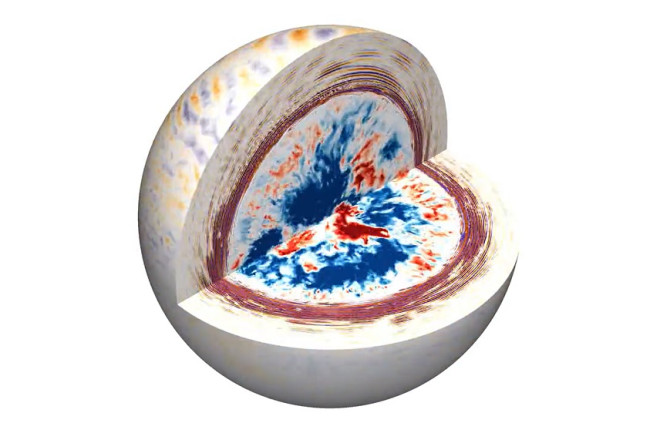Article: Unraveling the Mystery of Star Twinkling through Computer Models
In the depths of stars, fusion reactions occur, causing hydrogen atoms to merge and form helium, resulting in a release of energy. This energy generates heat, which then rises towards the outer layers of the star. Along the way, it triggers waves that persist for hundreds of thousands of years. These waves have been previously associated with the peculiar flickering observed in the light emitted by massive and hot stars. Scientists suspected that these convection waves, by compressing or decompressing the plasma on the star’s surface, would momentarily impact how the star appears. However, a recent study has concluded that the twinkling effect caused by these waves is too insignificant to explain the pulsing “red noise” observed. Even with advanced telescopes like the James Webb Space Telescope, this twinkling effect is too minor to be detected. (It’s worth noting that flickering visible to the naked eye is caused by atmospheric interference). Nevertheless, there are potential scenarios, such as fast-spinning stars, where the flickering may be bright enough to be observed. Matteo Cantiello, a research scientist at the Flatiron Institute’s Center for Computational Astrophysics, explains that they are eager to find an answer to this intriguing question.
The Importance of Star Twinkling: Shedding Light on the Universe
Why should we care about the twinkling of distant stars? As part of their study, a team from the Flatiron Institute and Northwestern University developed a revolutionary computer model capable of determining a star’s twinkling based on its internal waves. Interestingly, this model also works in reverse—a pattern of observed twinkling can be used to reverse engineer the star’s inner dynamics. Understanding the inner workings of stars is crucial as they significantly impact the formation of galaxies and produce the oxygen vital for our survival.
Discovering Music in Space: Simulating Stellar Cores
Simulating the cores of stars represents a significant challenge due to the short duration of heating events lasting a few weeks, contrasting with the enduring nature of resulting waves that can last for hundreds of thousands of years. To tackle this, the researchers drew an analogy to sound oscillations produced by a musician in a music hall. Initially, they simulated the reverberations of music within a star, including the iconic tunes of “Twinkle, Twinkle Little Star” and the Jupiter movement from Gustav Holst’s “The Planets” orchestral suite. The sound varied, appearing either ethereal or dreamy and melodic, depending on the star’s size. When the researchers incorporated convection waves into their model, they discovered that the resulting twinkling was too faint to account for the observed red noise. However, this is not the end of the story. Evan Anders, a postdoctoral researcher at Northwestern University, emphasizes the significance of this work in enabling future space telescopes to explore the core regions of stars, where the essential elements for sustaining life are forged.
Read More: Surprising Possibility of Habitable Exoplanets Unseen by the Naked Eye
Are you already a subscriber? Register or Log In to gain access to this engaging content for as little as $1.99!
